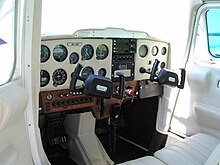Yoke (aeronautics)
Small to medium-size aircraft, usually limited to propeller-driven, feature a mechanical system whereby the yoke is connected directly to the control surfaces with cables and rods.[5][6] Side-sticks and centre-sticks are better for making rapid control inputs and dealing with high g-forces, hence their use in military, sport, and aerobatic aircraft.[7] The yoke often incorporates other key functions such as housing thumb or finger buttons to enable the radio microphone, disengage the autopilot, and trim the aircraft.Airships use a ship's wheel, helicopters use a cyclic,[14] and the majority of military fighter aircraft use a center or side-stick.The latest Airbus family of passenger jets use a side-stick, similar to a joystick, to actuate control surfaces.






Boeing Future of Flight MuseumConcordeEmbraer ERJCessna 152Lisunov Li-2Cirrus SR22Cessna 162 Skycatcherpilotingfixed-wing aircraftattitudeaileronselevatorfly-by-wireactuatorsstick shakerstick pusherEmbraersteering wheelCirrus SR20side stickCessna 162Side-stickscentre-sticksg-forcesautopilotchronometerAirshipsship's wheelhelicopterscyclicfighter aircraftcenterside-stickjoystickcomputerinput devicesflight simulatorsIndex of aviation articlesAircraft flight control systemRudder pedalsFlyingAirbusAircraftsystemsAirframeAft pressure bulkheadCabane strutCanopyCrack arrestorCruciform tailEmpennageFabric coveringFairingFlying wiresFormerFuselageHardpointInterplane strutJury strutLeading edgeLift strutLongeronNacelleStabilizerStressed skinT-tailTailplaneTrailing edgeTwin tailV-tailVertical stabilizerWing rootWing tipWingboxFlight controlsAileronAirbrakeCanardCentre stickDeceleronDive brakeDual controlElectro-hydraulic actuatorElevonFlaperonFlight control modesGust lockServo tabSpoilerSpoileronStabilatorTrim tabWing warpingYaw damperAerodynamichigh-liftActive Aeroelastic WingAdaptive compliant wingAnti-shock bodyBlown flapChannel wingDrag-reducing aerospikeGouge flapGurney flapKrueger flapLeading-edge cuffLeading-edge droop flapStall stripsStrakeVariable-sweep wingVortex generatorVortilonWing fenceWingletAvionicflightinstrumentAir data boomAir data computerAircraft periscopeAirspeed indicatorAltimeterAnnunciator panelAstrodomeAttitude indicatorCompassCourse deviation indicator